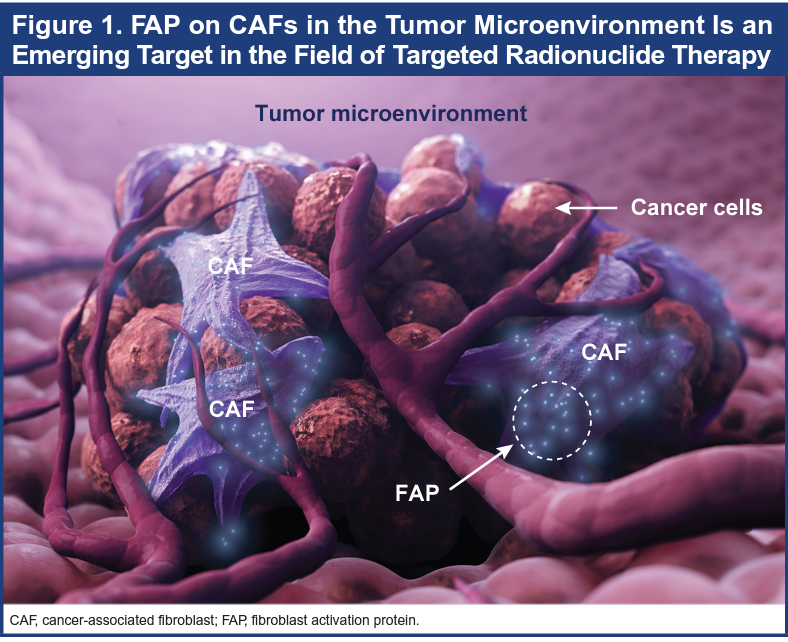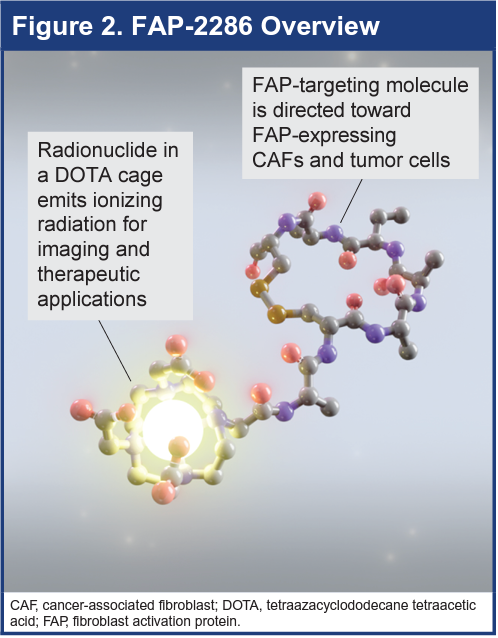Article
Non-Clinical Study Data Show Potential of FAP-2286 in Tumor Inhibition
Author(s):
Peptide-targeted radionuclide therapy FAP-2286 (Clovis Oncology) showed potent affinity for human fibroblast activation protein by biochemical and cell-based assays.
A non-clinical data analysis presented at the American Association for Cancer Research (AACR) Annual Meeting 2022 found the peptide-targeted radionuclide therapy (PTRT) FAP-2286 (Clovis Oncology) showed potent affinity for human fibroblast activation protein (FAP) by biochemical and cell-based assays. Further, lutetium-177 (177Lu)-FAP-2286 produced longer tumor retention and resulted in increased tumor inhibition versus lutetium-177 (177Lu)-FAPI-46, a FAP-targeted radiotracer developed for therapeutic use.
The analysis noted that FAP is an emerging target in peptide-targeted radionuclide therapy and imaging. The membrane-bound protease is highly expressed on the surface of cancer-associated fibroblasts found in the tumor microenvironment of most epithelial cancers and on some tumor cells (Figure 1).

Credit: Clovis Oncology
FAP-2286 is the first PTRT and imaging agent targeting FAP to enter clinical development, according to Clovis Oncology. The manufacturer plans to enroll 50 patients with advanced solid tumors in the phase 1 portion of the multicenter, open-label LuMIERE trial (NCT04939610).
In preclinical studies, the peptide-targeted radionuclide therapy directed toward FAP with FAP-2286 showed antitumor activity. The phase 1 portion of the trial will analyze the safety and tolerability, pharmacokinetics, dosimetry, and preliminary activity of 177Lu-FAP-2286 and identify the recommended phase 2 dose and schedule, as well as the safety and tumor uptake of the imaging agent gallium-68 (68Ga)-FAP-2286.
FAP-targeted radiotracers have shown encouraging results as imaging agents, with high uptake observed across multiple tumor types.
FAP-2286 is comprised of a low-molecular-weight cyclic peptide that potently and selectively attaches to FAP and a tetraazacyclododecane tetraacetic acid (DOTA) cage capable of carrying a radionuclide for therapeutic (eg, lutetium-177) or imaging (eg, gallium-68) applications, according to Clovis (Figure 2). In preclinical models, 177Lu-FAP-2286 was found to produce prolonged retention time and significant tumor growth inhibition.

Credit: Clovis Oncology
During the trial, patients will have single-photon emission computerized tomography/CT scans at 4, 24, 48, and 168 hours after each dose to calculate organ and tumor dosimetry. Serial whole blood samples will be collected at cycle 1 beginning at the end of infusion through 168 hours after the first dose of 177Lu-FAP-2286.
To measure efficacy, investigators will evaluate target and nontarget lesions for evidence of radiographic response based on RECIST. They will also perform tumor assessments at baseline, at the end of every 6 weeks during treatment, every 12 weeks for 2 years, every 6 months until 5 years, and then annually thereafter.
After the phase 2 therapeutic dose is determined, phase 2 expansion cohorts in multiple tumor types are planned for later in 2022.
"The non-clinical data presented at AACR further show the potential of FAP-2286, our first targeted radiotherapy candidate, as a therapeutic and imaging agent and we look forward to sharing initial clinical data from the phase 1 portion of the LuMIERE study of FAP-2286 later this year," said Patrick J. Mahaffy, president and CEO of Clovis Oncology, in a press release.
Reference
McConathy, J., et al. LuMIERE: A Phase 1/2 Study Investigating Safety, Pharmacokinetics, Dosimetry, and Preliminary AntitumorActivity of 177Lu-FAP-2286 in Patients With Advanced or Metastatic Solid Tumors. Poster presentation. Accessed April 11, 2022. https://finance.yahoo.com/news/clovis-oncology-highlights-presentations-fap-120000601.html






